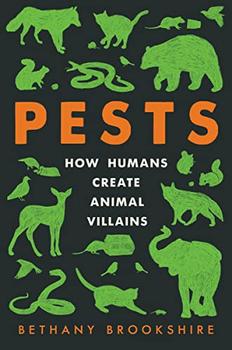Summary | Excerpt | Reviews | Beyond the Book | Readalikes | Genres & Themes | Author Bio

How Humans Create Animal Villains
by Bethany Brookshire
People didn't just store things, they also began to settle down. By building shelters, humans began to alter the environment around us. Along with our first huts, we built a humancentric ecosystem. A system other animals wanted into, and that we wanted to keep them out of.
When people raised in Western education systems think of ecosystems, they might remember a school science class. The teacher shows a forest and then a food web. The soil supports the trees. The trees convert air and sunlight into sugars for energy and growth and provide places for songbirds and squirrels to live. The squirrels and birds feast on the plants, and the foxes and owls snack on the squirrels and songbirds. Bugs and fungus decompose the leftovers. It's the circle of life.
Ecosystems, though, are more than food webs. They're the sum total of every organism in a place, and how those organisms interact with their habitat and with each other. They're not just deserts or forests or tundra. A city, town, or farm is also an ecosystem. Ecosystems can be environments that humans create, often without any idea we are doing it.
Every ecosystem has niches—places where organisms can thrive. Some are prime real estate—tropical forests, coral reefs, or fertile marshlands. Others are for more rugged critters. Hot, gaseous hydrothermal vents bubbling up from the sea floor might not look like a happy home to us, but deep-sea crabs and tube worms would beg to differ. A sewer might be too much for a discriminating salamander. But a rat is not so picky.
Humans aren't the only animals that create ecosystems other creatures can use. Remoras live in the small swimming ecosystem of a shark, nibbling its cast-off skin. Beavers build dams (which some humans have cause to curse at) and create ponds that benefit species from waterfowl to moose. Caves full of bats produce mountains of guano—a rich menu for microorganisms and fungus. Those decomposers feed small bugs, which feed cave crickets. An entire ecosystem is based around a bat's behind.
Humans—like beavers or bats—aren't islands unto ourselves. We alter the environments around us. We build ecosystems of concrete and brick and steel. We dig tunnels in the earth, plant succulent, tasty vegetables in gardens, and create dark, shady nooks under roofs. We even create islands of safety, killing off predators that might eat our pests.
Human-built ecosystems—from urban concrete jungles to giant monoculture fields of canola—are invitations to animals in need. A glamorous coral-reef lifestyle it is not. But an organism can certainly make a good living, if they have the right skills. So species moved into our angular, rocklike ecosystems. They started making their living off the things we ignored, left out, or left behind.
EARLY SIGNS OF vermin control are everywhere, says Rowan Flad, an archaeologist at Harvard University. When looking for signs of prehistoric pest control, don't look for things that end up in museums, he says. Instead, look for latrines and garbage heaps. "The reason you put a trash pit outside your house, and not inside your house, is because you want the pests out there," he says. "And you want the decomposing crap to be over there, not inside." Every time scientists find an early crapper or trash can, they find evidence that humans didn't want to deal with the flies, rats, and other animals associated with their waste.
Walls and fence posts could also serve this function. When archaeologists find these defenses, Flad says, they could be against other humans—but they could also be against animals trying to get at human food. A fence can keep both deer and other humans from your garden, and a wall is proof against bandits and pests alike.
This demarcation between people and the natural world they lived in meant welcoming some animals in—the animals that became our dogs and pigs and sheep and cows. It also meant that other animals—predators and pests—began to be seen as unwelcome intrusions into our new and improved lifestyle. And those intruders had to go.
Excerpted from Pests by Bethany Brookshire. Copyright © 2022 by Bethany Brookshire. Excerpted by permission of Ecco. All rights reserved. No part of this excerpt may be reproduced or reprinted without permission in writing from the publisher.
I always find it more difficult to say the things I mean than the things I don't.
Click Here to find out who said this, as well as discovering other famous literary quotes!
Your guide toexceptional books
BookBrowse seeks out and recommends the best in contemporary fiction and nonfiction—books that not only engage and entertain but also deepen our understanding of ourselves and the world around us.